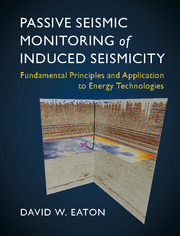 Passive Seismic Monitoring of Induced Seismicity
Passive Seismic Monitoring of Induced Seismicity Preface
Published online by Cambridge University Press: 07 June 2018
Summary
The past few decades have witnessed remarkable growth in the application of passive seismic monitoring to address a range of problems in geoscience and engineering, from large-scale tectonic studies to environmental investigations. Microseismic methods are a prime example of a passive-seismic approach applied to the study of brittle deformation in rocks. These methods are increasingly being used for in situ monitoring of fracture processes, including hydraulic-fracture stimulation of tight reservoirs, development of enhanced geothermal systems, assessment of caprock integrity for CO2 sequestration, life-cycle reservoir monitoring for heavy-oil production and monitoring of mining operations. The theoretical framework and techniques used in this emerging discipline draw from various established fields, such as earthquake seismology, exploration geophysics and rock mechanics. The aim of this book is to synthesize research and technology within this topic, which at present is widely scattered across disparate scientific and engineering communities and published in discipline-specific journals and conference proceedings.
This book is grounded in seismology, but draws from related disciplines including reservoir engineering and rock-, fracture-, earthquake-, continuum- and geo-mechanics. It provides an introduction to the principles and applications of microseismic monitoring and is aimed at undergraduate and graduate students in geophysics or engineering, as well as working geoscience professionals. The applications of microseismic methods are myriad and include surveillance of hydraulic stimulation for unconventional hydrocarbon development and enhanced geothermal systems, monitoring and verification of long-term underground storage such as CO2, and ensuring the safety of workers in deep underground mines. The theoretical underpinnings of passive-seismic monitoring include mathematical aspects of seismology, mechanics and signal processing, so it is assumed that readers will have a suitable background that includes mathematics and physics at the junior undergraduate level. A strong fundamental knowledge of these topics is key to achieving a quantitative understanding of the important industrial applications.
The interdisciplinary nature of passive-seismic monitoring means that mathematical expressions are rife with conflicting notation coming from established usage, across different disciplines, of identical symbols with utterly different meanings. This has necessitated a rather large dose of creativity in the use of subscripts and modifiers, in order to define a set of unique symbols for parameters and expressions that are used repeatedly.
- Type
- Chapter
- Information
- Passive Seismic Monitoring of Induced SeismicityFundamental Principles and Application to Energy Technologies, pp. ix - xPublisher: Cambridge University PressPrint publication year: 2018
